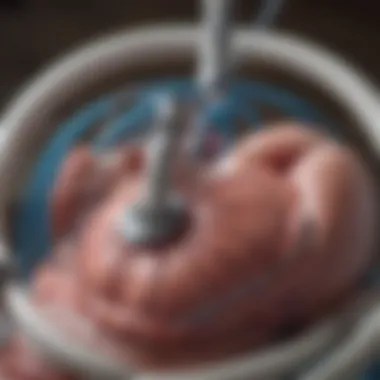Comprehensive Approaches to Right Ventricular Failure


Intro
Right ventricular failure (RVF) is a distinct and complex condition characterized by the inability of the right ventricle to maintain adequate blood flow, affecting the overall function of the heart. The clinical manifestation of RVF can significantly influence patient outcomes, necessitating a thorough examination of treatment strategies. This article presents a multi-faceted approach to managing RVF, covering pharmacological therapies, surgical interventions, and supportive care options—all tailored to meet individual patient needs. Understanding these treatments is essential for healthcare professionals, researchers, and educators involved in cardiology.
Key Findings
Major Results
Research into treatments for right ventricular failure has revealed several key insights. Factors such as underlying causes, severity of symptoms, and patient responses to initial treatments play crucial roles in determining the most effective management approach. Recent studies emphasize the efficacy of targeted pharmacological interventions, including diuretics and inotropes, which help relieve symptoms and enhance cardiac output.
"Effective management of RVF requires a comprehensive strategy that combines pharmacological, surgical, and supportive interventions tailored to the unique needs of the patient."
Additionally, the role of advanced heart therapies, such as continuous-flow left ventricular assist devices (LVADs), is gaining prominence. These devices provide support for both left and right ventricular function, improving hemodynamics and overall patient quality of life.
Discussion of Findings
The findings suggest that while several treatment options exist, no single approach universally applies to every patient. Personalized treatment plans must incorporate considerations like age, comorbid conditions, and patient preferences. Ongoing research remains essential to refine existing modalities and explore novel therapies that may emerge in the future. Integrating a multidisciplinary team comprising cardiologists, nurses, and other healthcare professionals is crucial to ensure comprehensive care for patients suffering from RVF.
Methodology
Research Design
This article builds upon an extensive review of current literature and clinical guidelines encompassing treatments for RVF. A qualitative approach is employed to synthesize findings from various studies, patient outcomes, and expert opinions in the field of cardiology.
Data Collection Methods
Data for this analysis is collected from peer-reviewed journals, clinical trials, and established healthcare databases. Sources considered include or are not limited to publications available through platforms like PubMed, Circulation, and the Journal of the American College of Cardiology. Insights from these resources are combined with observations from cardiology practitioners, ensuring a well-rounded perspective on treatment efficacy.
This structured approach aims to provide clarity on emerging trends and existing practices in managing right ventricular failure, ultimately enhancing understanding for all stakeholders in the field.
Understanding Right Ventricular Failure
Understanding right ventricular failure is crucial in the context of cardiovascular health. This type of heart failure occurs when the right ventricle cannot pump blood adequately to the lungs for oxygenation. The implications of right ventricular failure are significant as it often leads to a series of complications, worsening the patient's condition. Grasping the foundation of this condition allows healthcare professionals to adopt effective treatment strategies that can improve patient outcomes.
Definition and Pathophysiology
Right ventricular failure refers to the inability of the right ventricle to maintain an adequate cardiac output. This can result from various causes, including left-sided heart failure, pulmonary hypertension, and lung diseases. In pathophysiological terms, this failure often stems from increased pressure and volume overload, leading to ventricular dilation and hypertrophy. As the right ventricle struggles, systemic venous pressure increases, contributing to peripheral edema and fluid retention.
Understanding the pathophysiology enables precise interventions tailored to the underlying issues of right ventricular failure. It is essential to recognize that effective management goes beyond symptomatic treatment. Addressing the root causes is pivotal for improving hemodynamics and overall heart function.
Epidemiology
The epidemiological landscape of right ventricular failure highlights its prevalence and impact on diverse populations. Statistically, about 50% of patients with heart failure have some level of right ventricular dysfunction. Risk factors influencing this include age, gender, and comorbidities such as chronic obstructive pulmonary disease and pulmonary embolism. Specific demographics see higher incidences, indicating the need for targeted strategies in treatment and prevention.
The increasing awareness of the prevalence of right ventricular failure underscores the necessity of comprehensive research and clinical focus on the condition. Clinical guidelines must be informed by these epidemiological insights to address the growing healthcare challenge effectively.
Risk Factors
Several risk factors contribute to the development of right ventricular failure, each requiring distinct attention in terms of prevention and management. These include:
- Chronic Lung Diseases: Conditions like chronic obstructive pulmonary disease can lead to pulmonary hypertension, putting strain on the right ventricle.
- Left-Sided Heart Failure: The interdependence means that left heart failure can adversely affect the right heart's function.
- Obesity: Excess body weight increases the workload of the heart and may contribute to right ventricular dysfunction.
- Genetic Factors: A family history of heart disease can predispose individuals to right ventricular failure.
- Sedentary Lifestyle: Physical inactivity is linked to a higher risk of cardiovascular issues, including right ventricular failure.
By identifying these risk factors, clinicians can implement preventive measures or early interventions tailored to individual patient profiles. Understanding these aspects not only aids in treatment but also paves the path for public health initiatives aimed at reducing the burden of this condition.
"Understanding the multifactorial aspects of right ventricular failure enables the development of comprehensive treatment strategies to enhance patient care and outcomes."
Clinical Presentation
The clinical presentation of right ventricular failure (RVF) is a crucial aspect in understanding and managing this condition. This segment entails the signs and symptoms that typically manifest in patients suffering from RVF. Recognizing these clinical features is essential for timely intervention and effective treatment. It enhances diagnostic accuracy and can significantly influence patient outcomes. Without a clear picture of clinical presentation, healthcare professionals may face challenges in delivering appropriate care.
Symptoms and Signs
Symptoms of right ventricular failure may vary widely among patients, but several key indicators consistently arise. Common signs include:
- Dyspnea: This is one of the most prevalent symptoms. Patients often report difficulty in breathing during exertion, which may progress to rest during even minimal activity.
- Peripheral Edema: Swelling of the legs and ankles is frequent. Fluid retention is a consequence of inadequate blood circulation from the right ventricle.
- Fatigue: Many patients feel persistent tiredness, which affects their daily activities.
- Jugular Venous Distention (JVD): This sign can be observed during a physical exam, indicating increased pressure in the venous system due to right heart failure.
- Ascites: Accumulation of fluid in the abdominal cavity may occur, leading to discomfort.
- Cyanosis: A bluish discoloration of the skin can sometimes appear, particularly in the lips and fingers, due to low oxygen levels.
These symptoms not only help in identifying RVF but also provide insights into the severity of the condition. Healthcare practitioners must be vigilant, as these signs can overlap with other cardiovascular complications.
Diagnostic Criteria


Establishing a diagnosis of right ventricular failure requires a careful assessment that often employs the use of specific criteria. Several diagnostic tools and guidelines provide a framework for evaluation.
- Clinical History: A thorough history should be taken, focusing on the presence of risk factors like hypertension, pulmonary diseases, and previous cardiac complications.
- Physical Examination: Careful observation for signs of right heart failure is pivotal. Listening for heart sounds, checking for pulses, and observing for fluid overload are common practices.
- Echocardiography: This imaging technique plays a significant role. It can assess the structure and function of the right ventricle, helping to confirm diagnosis and stage severity.
- Cardiac MRI: Offers detailed images of the heart. It helps evaluate the heart's pumping efficiency and structural abnormalities, crucial to the management of RVF.
- B-type Natriuretic Peptide (BNP) Levels: This biomarker can be measured to corroborate heart failure diagnosis. Elevated levels indicate stress on the heart and promote further investigation.
- Chest X-ray: May show signs of right heart enlargement or pulmonary congestion, common in RVF cases.
The effectiveness of treatment greatly relies on accurate diagnosis following these criteria. Early identification and comprehension of the clinical presentation are vital steps in establishing an approach to managing right ventricular failure effectively.
Diagnosis of Right Ventricular Failure
Diagnosing right ventricular failure is a crucial step in managing this complex condition. It plays a significant role in guiding appropriate treatment strategies and ensuring that patients receive the care they need. Early and accurate diagnosis can lead to better outcomes by directing clinicians toward effective interventions that can alleviate symptoms, improve quality of life, and potentially prolong survival.
When considering diagnosis, clinicians will rely on various methods, such as imaging techniques and biomarkers. Understanding these methods is important simply because it allows for a holistic view of the patient's condition. Each method has its advantages and limitations, giving healthcare professionals multiple tools to assess right ventricular function accurately and efficiently.
Imaging Techniques
Echocardiography
Echocardiography is often the first-line imaging modality employed in the evaluation of right ventricular failure. Its non-invasive nature and availability make it a beneficial choice for both acute and chronic evaluation. A significant aspect of echocardiography is its ability to visualize cardiac structures and assess hemodynamics in real time.
A key characteristic of echocardiography is the Doppler imaging capabilities, which can measure blood flow velocities across the heart and vessels. Echocardiography provides data on right ventricular size, function, and pressure overload. The unique feature of this technique lies in its capacity to offer immediate feedback, facilitating timely clinical decisions. However, it has some limitations, such as operator dependency and challenges in visualizing the right ventricle in certain patients.
Cardiac MRI
Cardiac MRI offers detailed images of the heart, making it particularly useful in assessing right ventricular morphology and function. The primary advantage is its ability to produce high-resolution images that can outline the subtle changes associated with ventricular dysfunction.
One of the distinguishing features of cardiac MRI is its capability to provide functional assessments through tissue characterization. This can be particularly helpful in identifying infiltrative diseases affecting the myocardium. Despite its numerous benefits, cardiac MRI can be less accessible due to the need for specialized equipment and trained personnel. It may also have longer acquisition times compared to echocardiography.
CT Angiography
CT angiography is another imaging technique that can assist in diagnosing right ventricular failure, especially when pulmonary embolism is suspected. This method specializes in providing detailed images of blood vessels and can help visualize pulmonary arterial obstructions, a common cause of right ventricular strain.
The key characteristic of CT angiography is its rapid image acquisition, enabling timely diagnosis in acute scenarios. Patients may prefer it in some cases due to its less invasive nature compared to traditional catheter angiography. However, exposure to radiation and the use of contrast agents are significant considerations that must be addressed.
Biomarkers
Biomarkers are biochemical indicators that can aid clinicians in diagnosing right ventricular failure. These substances, often found in blood or other bodily fluids, can signal cardiovascular stress or damage. An essential group of biomarkers includes B-type natriuretic peptide (BNP) and its counterpart N-terminal proBNP (NT-proBNP). They are particularly useful for distinguishing cardiac causes of dyspnea.
The role of biomarkers extends beyond diagnosis. They can also provide insights into prognosis and guide therapy decisions. Recognizing the limitations of biomarkers is vital, as false positives or negatives can occur based on individual variations in disease states.
In summary, each diagnostic tool has distinct advantages and challenges. Relying on a combination of techniques maximizes the accuracy of diagnosing right ventricular failure, leading clinicians closer to implementing effective treatment strategies.
Pharmacological Treatments
Pharmacological treatments play a crucial role in managing right ventricular failure. Medications target various aspects of the condition, aiming to alleviate symptoms, improve hemodynamic function, and enhance overall patient outcomes. Pharmacologic approaches are tailored to the individual needs of each patient. Considering a patient's overall health, comorbidities, and specific presentation is essential for optimizing treatment. Understanding the distinct classes of medications helps clinicians make informed decisions, guiding interventions that serve the best interests of their patients.
Diuretics
Diuretics are often essential in the management of right ventricular failure. They help reduce fluid overload, a common issue in heart failure, which places additional strain on the heart. By promoting the excretion of sodium and water through the kidneys, diuretics alleviate symptoms such as edema and shortness of breath. Commonly used diuretics include furosemide and bumetanide. While effective, clinicians must monitor for potential side effects like electrolyte imbalances and dehydration.
Vasodilators
Vasodilators work by relaxing blood vessels, which can decrease the workload on the heart and improve blood flow. Agents such as nitrates and hydralazine may be utilized. They effectively lower systemic vascular resistance, thus improving cardiac output. Careful titration of these medications is important. Healthcare providers must be vigilant for side effects such as hypotension, which can lead to dizziness or fainting.
Inotropic Agents
Inotropic agents enhance the contractility of the heart muscle, thereby increasing cardiac output. Common choices include dobutamine and milrinone. These medications are especially beneficial in acute settings, where immediate improvement in heart function is necessary. However, prolonged use requires caution due to potential arrhythmias and decreased myocardial oxygen supply. Optimization of the dosing frequency and careful patient monitoring ensure safety and efficacy.
Anticoagulation Therapy
Anticoagulation therapy addresses the increased risk of thrombosis associated with right ventricular failure, particularly in patients with atrial fibrillation or significant right heart strain. Medications like warfarin or direct oral anticoagulants are commonly prescribed. These therapies aim to prevent thromboembolic events. Regular monitoring for therapeutic levels and side effects like bleeding complications is vital. By balancing the risks and benefits, clinicians can guide their patient's care effectively.
"Utilizing pharmacological treatments is not merely about prescribing medication but understanding the multifaceted nature of right ventricular failure to provide optimal patient-centered care."
Device-Based Therapies
Device-based therapies offer innovative solutions for patients suffering from right ventricular failure. These therapies are critical in providing support to the heart while addressing the underlying issues contributing to the failure. Additionally, they help improve cardiac function, potentially leading to better patient outcomes and quality of life. The integration of these devices has become instrumental in managing complex cases where conventional treatments may not suffice.
Implantable Cardioverter-Defibrillators (ICDs)
Implantable cardioverter-defibrillators, or ICDs, play a vital role in preventing sudden cardiac death due to arrhythmias. In patients with right ventricular failure, the risk of life-threatening ventricular tachyarrhythmias increases. ICDs continuously monitor the heart rhythm and can deliver shocks to restore normal rhythm when necessary. The incorporation of ICDs in treatment protocols has been shown to significantly reduce mortality rates in high-risk populations.
Considerations for ICD placement include the patient's overall functional status and the presence of arrhythmias. Regular follow-up is essential to ensure that the device functions properly and to reassess the patient's condition.


Cardiac Resynchronization Therapy (CRT)
Cardiac resynchronization therapy represents another impactful device-based intervention. CRT aims to improve the efficiency of heart contractions by coordinating the timing of the heart's contractions. This is especially beneficial in patients with heart failure characterized by specific conduction delays, such as those leading to right ventricular failure. By using a specially designed pacemaker, CRT can help improve both left and right ventricular function, alleviate symptoms, and enhance exercise tolerance.
Patients typically benefit from CRT if they exhibit a reduced ejection fraction and have not experienced significant improvement with medical therapies alone. The therapy should be tailored based on echocardiographic findings and clinical trials have shown that CRT can lead to significant improvements in quality of life and reduced hospital admissions.
Ventricular Assist Devices (VADs)
Ventricular assist devices provide mechanical support to the heart, assisting either the left or right ventricle. In cases where medications are ineffective, or in situations where heart transplantation is considered, VADs serve as a bridge to recovery or candidacy for transplant. They help maintain blood circulation while alleviating symptoms associated with right ventricular failure.
These devices can be either temporary or long-term, depending on the patient's needs. Surgeons usually implant VADs during open-heart surgery. Patients with VADs require ongoing care and monitoring, as complications such as infections or device malfunction can occur.
VADs have proven to significantly enhance survival and quality of life in patients with advanced heart failure, highlighting the importance of device-based therapies in contemporary cardiac care.
In summary, device-based therapies provide essential support for patients with right ventricular failure. The choice of therapy depends on multiple factors, including patient health and specific heart conditions. Each option—from ICDs to CRT to VADs—plays a distinct role in the overall management of right ventricular failure, reflecting the need for personalized treatment approaches.
Surgical Interventions
Surgical interventions play a crucial role in the management of right ventricular failure (RVF). These procedures aim to directly address the causes of RVF or improve the function of the right ventricle. Given the complexity of RVF and its impact on overall cardiovascular performance, surgery may be indicated when less invasive treatments are insufficient. Surgical options can provide significant benefits, including improved hemodynamic function, reduction of symptoms, and enhanced quality of life.
In selecting surgical interventions, several considerations come into play. Surgeons must evaluate the patient's overall health, the severity of RVF, and the presence of comorbid conditions. Additionally, a detailed understanding of the underlying etiology of the failure is necessary to tailor the surgical approach. For instance, structural abnormalities such as valvular heart disease or congenital defects may necessitate specific surgical repairs.
Pulmonary Valve Replacement
Pulmonary valve replacement is a key surgical option in treating RVF, especially in patients with pulmonary valve dysplasia, severe stenosis, or regurgitation. The condition can impede the outflow of blood from the right ventricle, leading to increased pressures and eventual RVF. During this procedure, the malfunctioning valve is removed and replaced with a prosthetic valve, which can be either mechanical or biological.
The benefits of pulmonary valve replacement are significant. It can lead to:
- Reduction in Right Ventricular Pressure: This decreases the load on the heart, improving its overall efficiency.
- Symptom Relief: Patients often report improved exercise tolerance and decreased fatigue post-surgery.
- Improved Quality of Life: By correcting the valvular problem, many patients can return to their daily activities with more confidence and less discomfort.
Recovery from this surgery typically involves close monitoring in a hospital setting, followed by a structured outpatient rehabilitation program. Understanding the postoperative care is essential for minimizing complications and optimizing recovery.
Right Ventricular Assist Device Implantation
Right ventricular assist device (RVAD) implantation is another advanced surgical intervention for managing RVF. This device is intended for patients whose right ventricle cannot maintain adequate blood flow. The RVAD supports the right ventricle by mechanically assisting with blood pumping, allowing it to rest and recover.
This intervention is particularly beneficial in cases of severe RVF related to:
- Acute Cardiac Events: Such as MI or cardiac surgery complications.
- Chronic Conditions: Including pulmonary hypertension or valvular heart disease.
The advantages of RVAD implantation include:
- Temporary Support During Recovery: The RVAD can stabilize the patient's condition while waiting for heart transplantation or until the right ventricle recovers.
- Reduced Symptoms: Devices can lead to immediate improvement in symptoms, enhancing overall functional capacity and well-being.
- Bridge to Recovery or Transplantation: For patients on the path to organ transplant, the RVAD can sustain life while awaiting a suitable donor.
However, the implantation of an RVAD comes with risks, such as infection and bleeding. A thorough evaluation and multidisciplinary approach are vital to ensure the best outcomes.
Surgical interventions for right ventricular failure represent a critical aspect of effective management, addressing both the symptoms and underlying causes.
Management of Comorbid Conditions
Managing comorbid conditions is crucial in the treatment approach for right ventricular failure. Patients often have multiple health issues that can exacerbate their current cardiovascular status. Effective management of these comorbidities can lead to better outcomes, reduced hospitalizations, and overall improved quality of life. Ignoring these conditions can result in an increased burden on the heart and undermine treatments aimed at alleviating right ventricular failure symptoms.
Chronic Obstructive Pulmonary Disease (COPD)
Chronic Obstructive Pulmonary Disease is prevalent among patients with right ventricular failure. COPD contributes to reduced oxygen levels in the blood, which can place additional strain on the right ventricle. Patients may experience exacerbations of COPD, leading to acute deterioration in heart function. There are key aspects to managing COPD in this context:
- Regular Monitoring: Patients should have routine assessments to monitor lung function.
- Pulmonary Rehabilitation: Programs that focus on breathing exercises can help improve lung capacity and overall stamina.
- Medication Management: Use of bronchodilators and corticosteroids can manage symptoms effectively.
By addressing COPD, healthcare providers can significantly impact the progression of right ventricular failure and improve patient outcomes.
Sleep Apnea
Sleep apnea is another common issue in patients suffering from right ventricular failure. This condition causes intermittent breathing cessation during sleep, which leads to decreased oxygenation. As a result, the heart may work harder, further compromising right ventricular function. Effective management strategies include:
- Continuous Positive Airway Pressure (CPAP): This device can keep airways open during sleep, reducing apneic events.
- Lifestyle Changes: Weight management and sleep positioning can significantly improve symptoms.
- Regular Sleep Studies: Monitoring the condition can guide treatment adjustments.
Addressing sleep apnea helps improve sleep quality, lowers nighttime strain on the heart, and enhances overall well-being.
Obesity


Obesity is a major risk factor for both right ventricular failure and its comorbid conditions, as it can lead to mechanical and metabolic changes that negatively affect heart function. Weight management strategies must be prioritized, including:
- Dietary Modifications: Implementing a balanced, low-sodium diet can aid in weight loss and improve heart health.
- Physical Activity: Encouraging regular physical exercise tailored to the patient's condition can help with weight control and improve cardiovascular function.
- Behavioral Support: Counseling and support groups can provide resources and motivation.
By managing obesity, patients can reduce their heart's workload and enhance the benefits of other treatments.
Role of Lifestyle Modifications
Lifestyle modifications play a crucial role in the management of right ventricular failure. Though medical and surgical interventions are essential, the impact of daily habits and lifestyle choices cannot be overstated. Lifestyle changes can improve hemodynamics, enhance medication efficacy, and foster a better quality of life for patients. It is vital that patients understand their role in their treatment plan and the potential benefits of making informed choices.
Dietary Changes
Dietary changes are often the first line of defense in managing right ventricular failure. A heart-healthy diet can reduce blood pressure, manage weight, and improve overall cardiovascular health. Here are key elements to consider:
- Sodium Restriction: Reducing salt intake can lessen fluid retention, a common problem in right ventricular failure. The American Heart Association recommends limiting sodium to less than 2,300 mg per day, with an ideal target of 1,500 mg for those with heart failure.
- Fluid Management: Some patients need to monitor their fluid intake, depending on their condition. Keeping a record can help reduce the risk of overload.
- Nutrient-Rich Foods: Emphasizing fruits, vegetables, whole grains, and lean proteins is important. Foods rich in potassium, like bananas and spinach, can also support heart function.
- Healthy Fats: Incorporating sources of omega-3 fatty acids, such as salmon and flaxseeds, can lower inflammation and improve heart health.
By adapting diet with these changes, patients can contribute to their recovery and potentially avoid more serious interventions.
Exercise Recommendations
Exercise is an integral part of managing right ventricular failure. Regular physical activity strengthens the heart, improves blood flow, and reduces feelings of fatigue. However, patients must approach exercise with caution and ideally under medical supervision. Here are important highlights:
- Consultation: Before starting any exercise program, patients should consult their healthcare provider for personalized advice.
- Types of Exercise: Low to moderate-intensity aerobic exercises are typically recommended. Activities such as walking, swimming, or cycling can be beneficial without overly straining the heart.
- Strength Training: This can help build muscle mass and improve stamina. Light weight training may be included, focusing on major muscle groups and maintaining proper form to avoid injury.
- Aim for Consistency: Patients should aim for at least 150 minutes of moderate aerobic activity per week, balanced with strength training on two days.
Ultimately, integrating recommended exercises into daily routines can help empower patients and enhance their physical function and emotional health.
"Active management of lifestyle factors is indispensable for those dealing with right ventricular failure. It empowers patients to take charge of their health, which is invaluable in treatment success."
In summary, the role of lifestyle modifications is significant in the management of right ventricular failure. Dietary changes and exercise recommendations serve as cornerstones in enhancing structural and functional recovery.
Psychosocial Considerations
The psychosocial aspects of right ventricular failure are often underestimated in clinical practice. Recognizing how this condition affects the psychological well-being of patients is crucial. This understanding can lead to better adherence to treatment plans and overall improved outcomes. Patients may experience various emotions, such as fear, anxiety, and depression, primarily due to the chronic nature of their condition and its potential impact on their lifespan.
Addressing these psychosocial factors can significantly enhance the quality of life. Mental health support should not be an afterthought but rather an integral part of the management plan. Patients who receive appropriate emotional support often show better engagement with their care, leading to practical benefits.
Mental Health Impact
Mental health impacts are significant in individuals with right ventricular failure. Many encounter stressful life changes that affect their emotional state. Studies indicate that almost 30% of patients may suffer from depression. These feelings can stem from dealing with physical limitations and chronic symptoms. An untreated mental health condition can worsen the patient's physcial health and hinder recovery.
Additionally, social isolation may ensue. Patients may withdraw from social activities due to embarrassment or fatigue. As a result, their sense of support diminishes, aggravating feelings of loneliness and despair.
Incorporating mental health screenings during clinical visits is advisable for healthcare providers. Early intervention can mitigate the effects of mental health issues, offering a more holistic approach to treatment.
Effective management of mental health can lead to improved adherence to treatment and better health outcomes for patients.
Patient Education
Educating patients about their condition plays a vital role in the overall management of right ventricular failure. Thorough understanding encourages patients to take an active role in their treatment. Knowledge about the symptoms, medications, and therapeutic approaches fosters a sense of empowerment. When patients know the specifics of what they are dealing with, they are more likely to comply with treatment recommendations. This includes lifestyle adjustments and medication adherence.
Educational efforts should also encompass information on warning signs. For example, inability to breathe or sudden weight gain indicates worsening symptoms. Knowing these signs can help in timely intervention, potentially avoiding severe complications.
Key elements for effective patient education include:
- Clear communication about their diagnosis.
- Information on available treatments and their potential side effects.
- Tips to manage symptoms effectively.
- Guidance on lifestyle modifications that enhance health.
Future Directions in Treatment
The future directions in the treatment of right ventricular failure (RVF) hold significant promise. As we learn more about the complexities of this condition, there are opportunities for developing targeted therapies that improve clinical outcomes. Understanding the future in treatment involves an exploration of both emerging pharmacotherapies and advancements in surgical techniques. These elements do not merely represent new innovations; they signify a shift in how we approach patient care and management in RVF. The rationale behind these advancements stems from the ongoing need to tailor treatments to individual patient characteristics and to incorporate more personalized medicine into cardiovascular care.
Emerging Pharmacotherapies
Pharmacotherapy is pivotal in managing RVF. Novel agents are being developed with the aim of improving hemodynamic stability and reducing morbidity. For instance, new classes of drugs targeting specific pathways involved in heart function are under investigation. Some agents aim to enhance myocardial contractility, while others focus on reducing pulmonary pressures, which is crucial in RVF. The potential benefits of these therapies can be profound.
- SGC Stimulators: One group of medications, soluble guanylate cyclase (SGC) stimulators, has shown promise in managing pulmonary hypertension, thereby alleviating some of the burdens on the right ventricle.
- Endothelin Receptor Antagonists: Another class, endothelin receptor antagonists, works by blocking substances that constrict blood vessels and elevate blood pressure, which could be particularly useful in patients with concurrent pulmonary hypertension.
- SGLT2 Inhibitors: Recently, sodium-glucose cotransporter-2 (SGLT2) inhibitors have garnered interest, primarily in their role in heart failure management and their effects on fluid regulation and diuresis.
The research surrounding these pharmacological innovations highlights not only their potential efficacy but also the need for further trials to establish optimal dosing, combinations, and long-term impacts.
Innovations in Surgical Techniques
Surgical interventions in RVF are undergoing evolution as well. As our understanding of cardiac anatomy and failure mechanisms improves, so do the strategies available to offer surgical solutions. Current innovations focus on minimally invasive techniques and novel surgical devices developed to optimize right ventricular function and increase the longevity of patients.
- Mechanical Assist Devices: The expansion of mechanical circulatory support devices, like the Impella, is a perfect example of innovation aimed at aiding the right ventricle during critical periods. These devices not only assist in blood circulation but also allow the heart muscle time to recover.
- Transcatheter Valve Interventions: Similarly, transcatheter interventions for valve replacements and repairs are being refined. These procedures minimize recovery time and reduce the overall risk for patients, which is essential given the often-fragile health status of those suffering from RVF.
- Hybrid Surgical Approaches: The use of hybrid surgical approaches combines traditional surgery with catheter-based techniques, providing a comprehensive solution tailored to the patient’s unique anatomy and condition.
"Emerging researchers will likely play a critical role in changing the landscape of RVF treatment, ensuring that therapies are effective and patient-centered."
In summary, the future directions of RVF treatment emphasize a detailed understanding of innovative pharmacological and surgical strategies. As these promising modalities emerge, they will likely redefine how healthcare professionals manage this challenging condition. Continuous research and clinical trials will be paramount in translating these innovations into standard practice, thereby enhancing patient outcomes and quality of life.



